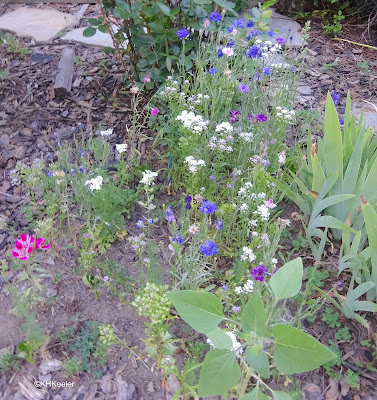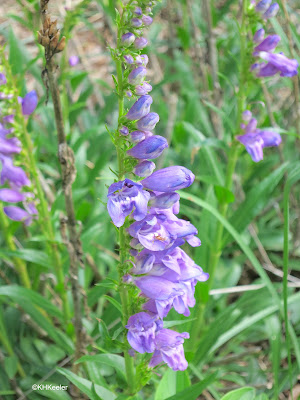There is a national push for homeowners in the U.S. to grow plants native to their area (see previous posts part1; part 2; part 3; HNPwebsite). The number of birds and insects have been dropping over the last 50 years. Lack of food is blamed because we replaced native habitat with lawns and parking lots. Rewilding our neighborhoods is not a realistic solution; what is suggested is that we each grow regional natives on our properties, making our yards contribute to local habitat.
 |
| Alpine clover Trifolium dasyphyllum, an alpine tundranative that won't survive in Denver, though the distance is only 50-60 miles. |
To expand on those points, most of the people in the U.S. are on the East and West Coasts. Those have quite different ecosystems and quite different native plants from Colorado, but with their bigger populations, more information is written for them.
The 'grow natives' movement came as a surprise to the garden industry and they are struggling to catch up. A few years ago, people were happy with mixed bright flowers, so "wildflower seeds" were often a mix of East- and West- Coast species (say, the eastern columbine, Aquilegia canadensis and California poppy, Eschscholzia californica) combined with hardy international garden flowers like bachelor buttons (Centaurea cyanus) and calendulas (Calendula officinalis). They sold those all over the U.S. (and still do). For Coloradans, maybe one or two of the ten species was actually a Colorado wildflower.
 |
| Cute garden flowers, but mostly not native to my area |
Today you can find Plains or Southwest wildflower mixes that lack the Eurasian species and are pretty characteristic of our region. But these mixes won't dominate the ads, because there are more buyers for Atlantic States and California wildflower mixes. Increasingly, though, ads are targeted and the websites recommending natives for your garden ask for your zip code. Zip codes are much better.
However, while the zip code is specific, the national data bases haven't had time to fine-tune them. Across the Virginia coast or eastern Kansas, zip code after zip code will have the same native species, so the websites can load them with the same recommendations and not worry about tailoring each zip code. Colorado is much tougher. My county, Larimer, goes from elevations of 4730' on the plains at the base of the Rockies to just over 14000' on the mountain tops. The ecosystems that takes you through are shortgrass steppe, foothills grassland, montane, subalpine and alpine tundra, plus some distinctive riverside plant communities. The native plants steadily change with elevation. At 5,000', I can't grow subalpine species, but a list of "what's native here" might bring them up. Colorado is too varied for simple solutions. You don't have to go more than a few miles before the natives will be different. That's just how it is on mountains.
On the two sides of the Rocky Mountains, east and west, many native plants are different.
There is enough change in temperature between northern Colorado and southern Colorado to produce habitats for different native plants. I can't grow the tree cholla, Cylindropuntia imbricata that you see along I-25 in southern Colorado. (Well, its native range and wild distribution is way south of me; stay tuned in global warming.)
Not only do we have natives that are often not shared with states east or west of us, the native plants vary at a very local level, so a list of what grows in your county is only a starting point, not a shopping list.
A complex state comes with substantial responsibility. People elsewhere are not going to save our natives; we have to do that.
Colorado is fortunate to have large National Parks, National Forests, and local open spaces. We have nevertheless filled our towns and cities with exotic species. Often, where we live, natives are hard to find.
Things are changing and people are planting local plants, but, just looking at my ordinary street, you can find only one (1) native in the front yard of about half of the houses, and just a few of those are growing more than five natives. In the other yards I could see no native Colorado plants. At one time, all the plants all along what is now my block were natives, so there has been a drastic drop in the amount of habitat available growing food for nesting birds. (Exotic species feed fewer insects than natives, see previous posts.)
Planting a single native or putting one into a flowerpot on the deck, is a meaningful step towards healthy local ecosystems.
The most practical way to find local plants to grow, despite all the flawed information available, is to shop locally. A native plant nursery close to home will recommend and offer plants that are local to your area.
You can shop the internet, but be very careful because Colorado is a small and unique region. For example, although there are 60 species of Penstemon (beardtongue) native to Colorado, the first three species that came up when I googled "buy Penstemon" do not include Colorado in their native range; they were Penstemon heterophyllus from California, P. davidsonii from the Pacific Coast (California to British Columbia) and P. digitalis found from Nebraska and Kansas east to the Atlantic.
 |
| a Colorado penstemon |
I love Colorado's native plants. They are diverse and very interesting. Having them in the yard means I can interact with them, not just glimpse them along a hiking trail.
 |
| the western prickly pear, Opuntia macrorhiza |
 | ||||
| leaves of Rocky Mountain bee plant, Cleome serrulata. |
Rocky mountain bee plant seedlings will grow up to have bright red purple flowers that attract bees and butterflies. The plant is related to capers. The leaves have an odor I do not like.
 |
| Missouri goldenrod, Solidago missouriensis all sorts of tiny insects are attracted to the flowers, ...followed by the small spiders that hunt them |
And, though there are frequent open lots in town where you can look out across grasses, most of those places had the natives eliminated decades ago and are currently growing weedy exotics like brome grass (Bromus), salsify (Tragopogon) and field bindweed (Convolvulus arvensis). The nearest prickly pear to mine is three houses down, I don't know anyone in my neighborhood (searching outward in circle) who grows Rocky Mountain bee plant or goldenrods. It is not as if even very common natives are easy to find in our neighborhoods.
Add a single native where you live, or plant a row for a splash of color, there is plenty for all of us to do.
Comments and corrections welcome.

No comments:
Post a Comment